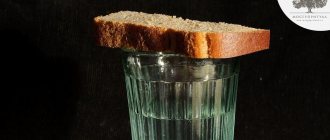Epiphany is a holiday that unites all Christians. Parishioners come to the church and to reservoirs with various containers to collect water, which, according to legend, becomes holy and healing. Usually people collect more holy water than they need, and by the end of the year, for the next Epiphany, they still have decent supplies left. The clergy do not recommend simply pouring out blessed water, and zealous owners often ask the question: “Is it possible to water flowers with holy water?” To find out the answer, you need to find out what this “living” liquid actually is, and what can happen if you water your plants with it.
Is it possible to water flowers with holy water?
Holy water
Properties and features of holy water
Holy water is a liquid consecrated during the rite of Great Consecration, which is held on the day of the great Christian holiday of Epiphany or Epiphany, celebrated on January 19 annually, as well as on Epiphany Eve, which is celebrated the day before, namely on January 18. That is why such water is also often called Epiphany water.
During the rite of consecration, a cross is lowered into vats of water and Jordan-holes on reservoirs, accompanied by prayers, by the clergyman. This is why water becomes healing.
A priest lowers a cross into the water during a ceremony
Water taken from an Orthodox church on any day will also be holy. At the same time, it accompanies a believer throughout his entire life, starting from the moment of baptism, when a baby or an adult plunges into the font three times. According to legend, in this way you can wash away your sins and start a new life.
Both the water that parishioners collect at Epiphany and the liquid that parishioners filled containers with on Epiphany Eve are considered holy and have unique characteristics.
- It does not spoil even with long-term storage - sometimes even 10 years pass, and it is still as fresh as it was on the first day. If the water does spoil, it means that it was either collected in a dirty container, or is in an unfavorable energy environment (for example, in a house where there is constant fighting).
- If you add a few drops of holy water to ordinary water, the first one seems to convey its unique properties. Therefore, the liquid shrine can be “multiplied” if there is little of it left.
- Holy water can improve the patient’s condition, mood, and add strength. There have been cases when even serious illnesses receded and the person felt better. Inexplicable but the fact.
- Living spaces sprinkled with holy water in the corners become more comfortable.
- According to beliefs, holy water drives out evil spirits, calms people down, and allows them to cope with their sinful desires.
Baby Baptism
What can cause the Epiphany water left over from last year to spoil?
According to practice, despite the fact that Epiphany water is accepted as a liquid that never spoils, it can still become unusable. It is noted that this happens most often for several reasons. They can be associated both with the conditions of storage of Epiphany water and with the emotional situation that reigns in the home of Christian believers.
Space is to blame for everything...
Scientist Mikhail Vasilyevich Kurik (Ukraine), who was engaged in research on the state and properties of water, found out why it is on the Epiphany holiday that water becomes holy or bioactive, as scientists call it. The scientist decided to conduct an experiment: starting from December 22 and until the feast of Epiphany, he took water samples every day and observed how the structure changed and what happened to the liquid. As a result, Mikhail Vasilyevich concluded that water becomes unique due to the special influence of the energy fields of the Sun, Moon and planet Earth, as well as cosmic radiation and energy fields of other celestial bodies of the Solar system. Thus, the scientist was able to explain the unique properties of holy water from the point of view of the laws of nature.
The fact is that every year on the same day, January 19, our planet, together with the entire solar system, crosses the field of influence of special rays, a change in the gravitational fields in the space of the entire Galaxy occurs, as a result of which the bioenergy of water on Earth increases.
Holy water is believed to have healing properties
Research on holy water was also carried out by scientist Anton Belsky (Russia), who for a number of years on the eve of January 19 recorded active bursts of neutron flux in outer space - they exceeded background levels by more than 100 times! The maximum level of surges occurred from January 17 to 19 in different years. As a result of these influences, water is purified and charged with positive energy.
That is, even from the point of view of science, the existence of holy water is explainable, and this is not fiction or a biblical fairy tale. It is on January 18 and 19 that the Sun and our planet are positioned in such a way that a certain connection arises between the Earth and the central part of the galactic system. This connection forces everything around to interact and be structured on a completely different level.
On January 18-19, a connection arises between our planet and the central part of the galactic system. That's what one theory goes, at least.
Where can you put the Epiphany water left over from last year?
It is noted that Epiphany water, which has deteriorated due to improper storage, must be disposed of. However, church rules also pay some attention to this process. Christian believers should rely on them even in the case in which the baptismal water has not spoiled, but it still needs to be poured out for one reason or another.
According to the rules of the Orthodox Church, last year's Epiphany water cannot be poured into the sink. It is forbidden to allow the shrine to come into contact with ordinary, unconsecrated pipeline fluid. This will be considered a desecration of baptismal water. So, in a case in which it has become unusable, as well as in some other situations, the liquid must be dealt with in a certain way:
- pour the water into an open reservoir. A stream, river, or other place with a current may be suitable;
- well. Water can be poured into such a place only on the recommendations of a clergyman;
- unused piece of land. You can pour water into a place where neither people nor animals walk.
Church rules also state that when disposing of last year's Epiphany water, Orthodox believers must thank the shrine for the benefits that it provided. After this, some clergy also recommend praying, and washing the vessel in which the water was stored and using it next year for the same purposes.
How is holy water used?
Christians can use holy water in several ways and for several purposes. It is advised to drink it a little every morning after prayer during illness. She is also regularly sprinkled on the house, food, and various objects, such as icons. You should only collect water for Epiphany in clean jars so that no debris or dirt gets into it. Holy water should be stored at home in the Red Corner next to the icons. And on the lid you can write the year when it was collected. It is customary to share excess water with family and friends who, for some reason, were unable to collect it themselves - in this case, there is no need to skimp.
Prosphora and holy water
Since holy water does not spoil, it can last for more than one year. But many do not dare to drink it and do not even use last year’s drink. At the same time, under no circumstances should old water be poured into the toilet, sink, or thrown out onto the street. In this regard, many try to use it for other good purposes - for example, sprinkling pets or watering flowers.
Where can I pour it?
It is better to store the shrine next to the icons.
The vessel with holy water is kept in a dark place, next to household icons. With respect, water retains its healing properties for a long time. But if stored incorrectly, water can lose freshness and spoil (we described the reasons for this here). In this case, it would be correct to pour out last year’s water. However, there are certain places where liquid can be disposed of and where it should not be poured. Acceptable locations include:
- An untrodden place. It is allowed to use any piece of land where no person walks or where stray animals do not run.
- Open water. The best solution is to pour old holy water into a river or stream with a current.
- Dry well or drainage system at the temple. Draining is carried out with the permission of the priest.
It is considered unacceptable for consecrated moisture to come into contact with sewage - a sewer drain or a cesspool. Pouring liquid into a sink or toilet is considered extreme disrespect for something sacred.
When pouring water, you need to say words of gratitude for the time it was in the house.
For many centuries, holy water has given hope to praying people, strengthened faith and given strength. The healing properties are accepted and approved by the Church. A respectful attitude towards agiasma gives it great power, and it, in turn, helps in family and everyday situations.
Holy water and plants
Surprisingly, holy water also has a beneficial effect on plants - this can be judged by the numerous reviews of those who regularly use it themselves and water indoor flowers. For example, one of the Internet users tells how she managed to get out of a completely hopeless money tree. It died, was cut off at the root and eventually dried up completely. But they didn’t get around to throwing up their hands. A woman accidentally found a bottle of old holy water at home and poured it into a flower pot. And just a few days later, fresh green leaves appeared on the cut of the money tree trunk.
Plants can be watered with holy water
And in France, one man decided to conduct an experiment: he planted four tomatoes, two of which were control ones - one was constantly cursed and watered with ordinary water, the second received a dose of holy water and prayer. As a result, the first tomato died, and the second one grew and produced a large harvest. A similar experiment was carried out by Japanese resident Masaru Emoto, who watered individual plants with charged water, reading a prayer over it, and gave others regular water. He noted that the first plants grew faster and better than the second, although the water for irrigation was taken from the same reservoir.
The opinion of the priests
Priests of Orthodox churches prohibit pouring holy water anywhere, but they fully support the idea of watering indoor and garden plants with old water. If there are none, the holy liquid can be taken to the temple territory and poured there under a tree or bush. Some of it will evaporate, and some will absorb moisture from the plant.
On a note! By the way, you shouldn’t even wash your face with holy water over a sink; it’s better to do it over a flower. It is not good if the shrine ends up in the sewer. And in the territories of some temples there are also special wells into which old holy water can also be poured with the permission of the priest.
Well near the temple
What can cause Epiphany water to spoil?
Many clergy note that sometimes people take what Orthodox rules tell them too seriously. Thus, some categories of citizens in modern times still believe that holy water can spoil due to the influence of negative energy or because one of the family members has done a great deal and will soon be punished by God. This opinion began to be increasingly refuted by clergy.
In fact, Epiphany water can spoil due to the same thing as ordinary liquid that flows from a tap. To preserve holy water until the next celebration of Epiphany, it must be stored in a dark place so that the vessel is rarely exposed to sunlight. In addition, the container itself in which the holy water is located must be clean. Otherwise, bacteria will enter the liquid and it will be unsuitable for further use.
It is interesting that many Orthodox people noted how Epiphany water deteriorates due to external factors. Thus, there were cases when the holy liquid was poured into a bottle of vodka or other alcohol, and because of this it deteriorated over time. Therefore, clergy recommend pouring water only into a vessel that has not been previously desecrated.
Why do plants need water?
It’s worth talking briefly about why plants need water. Yes, without life-giving moisture they will die, but what explains this process? It’s simple - they need water (and we, by the way, too) to carry out certain life processes.
Let's remember the school biology course: plants consist of 80% water, which is part of not only stems and leaves, but also seeds and fruits. It supports various metabolic processes occurring at the cellular level and transports nutrients to the tissues of a living organism. Water is involved in photosynthesis, protects plants from overheating, and gives tissues firmness and elasticity.
Water is vital for all plants
Water dissolves salts and transfers minerals from the soil to the roots of plants, which, in turn, with its help, transfer all the elements necessary for plants higher up - to the stem, leaves, and fruits. If crops are not watered, they will gradually wither, wither, turn yellow and die.
DIY drip irrigation from plastic bottles
Drip irrigation refers to a special crop irrigation system in which moisture drops into the ground to the roots of plants grown in a greenhouse. You can organize drip irrigation using ordinary plastic bottles.
Rules for watering flowers
Plants, especially indoor flowers, need regular watering. But he shouldn’t be thoughtless - the wrong amount of water can kill your green friend. The instructions below will tell you how to properly water flowers.
Step 1. For quality watering, the plants must be planted correctly. Be sure to take a pot with drainage holes at the bottom so that excess moisture can flow out of it.
Drainage hole at the bottom of the pot
Step 2. Use loose and light soil, selected for a specific type of plant. Before planting the flower, add some drainage material, such as expanded clay, to the bottom of the pot.
Soil for planting
On a note! The pot doesn't have to be big! When replanting, use a container only 5 cm wider than the previous pot.
Step 3. Water indoor plants only as needed and as recommended in the flower description. Don't adjust watering to fit your schedule, but adapt it to the needs of the plants. Be sure to take into account seasonality and climatic conditions.
Watering a houseplant
Step 4. The soil and appearance of the plants will help you determine the need for watering. Feel the soil and look at the tray under the pot - if there is water in it, then you are watering too intensely.
We focus on the need for watering
Step 5. If you notice signs of wilting in the plant or see yellowed leaves, then it clearly does not have enough moisture.
Yellowed leaves are a sign of insufficient watering
Step 6. Feel the soil, plunge your finger into it to a depth of about 2-2.5 cm. The soil can be dry, wet or damp. In the first case, the flower needs water.
Checking soil moisture
Step 7. If the soil feels damp to the touch, but the flower clearly feels unwell, then most likely you flood it. Reduce watering immediately. If the soil is dry and the plant feels great, then look through a guide to indoor flowers - maybe this flower does not need constantly moist soil.
The soil in this pot is moist
Step 8. Water the flowers until fresh water begins to flow into the tray. After watering, pour out excess moisture from it. If the soil is dry, water the plant by submersion (immerse the pot in a basin of water for an hour).
Watering a houseplant with your own hands
On a note! Water your indoor plants only with settled water at room temperature. Ideally, you should use melt or rain water. Also, when watering, always direct the stream at the root, and not at the leaves or buds.
Video - How to water flowers
Soil prices
soil for plants











